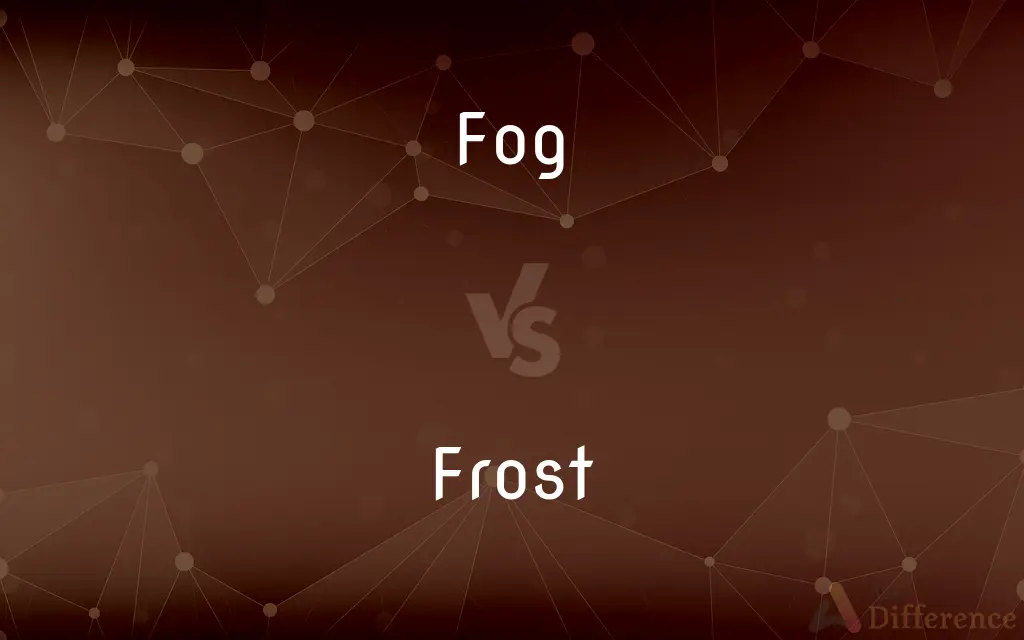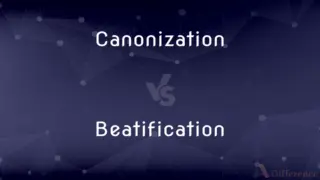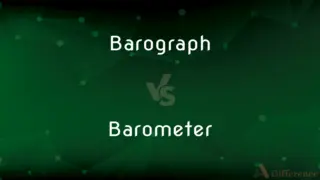Fog vs. Frost — What's the Difference?
By Urooj Arif & Fiza Rafique — Updated on March 10, 2024
Fog is a weather phenomenon consisting of suspended water droplets that reduce visibility, while frost forms when water vapor freezes on surfaces, often creating a white, crystalline layer.

Difference Between Fog and Frost
Table of Contents
ADVERTISEMENT
Key Differences
Fog occurs when water droplets are suspended in the air near the Earth's surface, significantly reducing visibility. This meteorological condition is common in areas with high humidity and significant differences in temperature between the air and the ground. Frost, on the other hand, forms on solid surfaces when the temperature drops below freezing, and water vapor from the air directly deposits as ice crystals, creating a white, crystalline layer. Unlike fog, which can reduce visibility in the air, frost affects surfaces, making them slippery and often covering them with a thin layer of ice.
The formation of fog requires a high level of humidity and a small temperature difference between the air and the dew point, leading to the condensation of water vapor into tiny droplets that remain suspended in the air. Frost formation, conversely, requires that the temperature of surfaces fall below the freezing point of water, allowing water vapor to change directly into ice without becoming liquid first. This process, known as deposition, results in the distinct, delicate patterns of frost that are often observed on windows, grass, and cars during cold mornings.
While fog primarily impacts visibility, making navigation and driving more challenging, frost affects the physical condition of surfaces. Frost can lead to hazardous conditions on roads, sidewalks, and other surfaces by creating a slippery layer of ice. The implications of fog and frost are thus different, with fog posing risks to transportation and outdoor activities due to reduced visibility, and frost creating potential hazards due to the icy conditions it can produce on surfaces.
Both fog and frost are weather phenomena that occur under specific atmospheric conditions, but their presence and effects are distinctly different. Fog can envelop landscapes, bodies of water, and urban areas, creating a mystic or eerie ambiance, but it does not directly affect the temperature of the environment. Frost, while visually striking, especially when it forms intricate patterns on surfaces, signifies the presence of freezing temperatures and can impact plant life by causing damage to crops and sensitive vegetation.
Understanding the difference between fog and frost is important for preparing for and responding to these weather conditions. While both can signal changes in weather and impact daily life, their formation, appearance, and effects on the environment and human activity are unique. Awareness of these differences helps in making informed decisions regarding travel, agriculture, and outdoor activities during conditions that favor the occurrence of fog or frost.
ADVERTISEMENT
Comparison Chart
Definition
Suspended water droplets in the air that reduce visibility.
Frozen water vapor on surfaces, forming a white, crystalline layer.
Formation Conditions
High humidity and small temperature difference between air and dew point.
Temperature of surfaces below freezing point, leading to deposition of water vapor as ice.
Impact on Visibility
Significantly reduces visibility, affecting navigation and driving.
Does not affect visibility but creates a slippery layer on surfaces.
Primary Effects
Reduced visibility leading to potential transportation and safety hazards.
Creates icy conditions on surfaces, posing slip and fall hazards.
Occurrence
Can happen in a variety of climates, especially with high humidity and temperature differences.
Requires freezing temperatures, common in cold climates or during winter seasons.
Compare with Definitions
Fog
A cloud on the ground, composed of tiny water droplets suspended in the air.
The morning fog obscured the bridge completely from view.
Frost
A layer of tiny ice crystals formed by the freezing of water vapor on cold surfaces.
A thin layer of frost covered the grass early in the morning.
Fog
Poses significant risks to vehicles and ships.
Ferry services were delayed due to poor visibility from the fog.
Frost
Can damage crops and sensitive plants by freezing the water inside plant cells.
The sudden frost caused significant damage to the vineyard's early buds.
Fog
Reduces visibility, sometimes to less than a few meters.
The heavy fog made driving conditions hazardous.
Frost
Creates a white, crystalline layer that can make surfaces slippery.
The frost made the sidewalks treacherous to walk on.
Fog
Common in humid areas or where warm, moist air meets cooler surfaces.
Coastal regions frequently experience fog due to the cold ocean currents.
Frost
Requires freezing temperatures, usually occurring during clear, cold nights.
Frost is common in the winter months, especially in rural areas.
Fog
Results from the condensation of water vapor near the Earth's surface.
As the temperature dropped, the dense fog began to form over the lake.
Frost
Occurs when the surface temperature falls below the freezing point, causing water vapor to freeze.
Overnight, the clear skies and calm winds led to widespread frost formation.
Fog
Fog is a visible aerosol consisting of tiny water droplets or ice crystals suspended in the air at or near the Earth's surface. Fog can be considered a type of low-lying cloud usually resembling stratus, and is heavily influenced by nearby bodies of water, topography, and wind conditions.
Frost
Frost is a thin layer of ice on a solid surface, which forms from water vapor in an above-freezing atmosphere coming in contact with a solid surface whose temperature is below freezing, and resulting in a phase change from water vapor (a gas) to ice (a solid) as the water vapor reaches the freezing point. In temperate climates, it most commonly appears on surfaces near the ground as fragile white crystals; in cold climates, it occurs in a greater variety of forms.
Fog
A thick cloud of tiny water droplets suspended in the atmosphere at or near the earth's surface which obscures or restricts visibility (to a greater extent than mist; strictly, reducing visibility to below 1 km)
The collision occurred in thick fog
Frost
A deposit of small white ice crystals formed on the ground or other surfaces when the temperature falls below freezing
The lanes were glistening with frost
It is not unusual for buds to be nipped by frost
Fog
A state or cause of perplexity or confusion
The coffee helped clear the fog in my brain
Frost
Cover (something) with or as if with frost; freeze
Shop windows were still frosted over
Fog
The grass which grows in a field after a crop of hay has been taken.
Frost
Decorate (a cake or biscuit) with icing
The cake Mama had just frosted
Fog
(with reference to a glass surface) cover or become covered with steam
The windscreen was starting to fog up
Hot steam drifted about her, fogging up the window
Frost
A deposit of minute ice crystals formed when water vapor condenses at a temperature below freezing.
Fog
Bewilder or puzzle
She stared at him, confusion fogging her brain
Frost
A period of weather when such deposits form.
Fog
Spray with an insecticide.
Frost
A cold manner or period of disaffection
A frost in diplomatic relations.
Fog
Condensed water vapor in cloudlike masses lying close to the ground and limiting visibility.
Frost
To cover with frost.
Fog
An obscuring haze, as of atmospheric dust or smoke.
Frost
To cover (glass, for example) with a roughened or speckled decorative surface.
Fog
A mist or film clouding a surface, as of a window, lens, or mirror.
Frost
To cover or decorate with icing
Frost a cake.
Fog
A cloud of vaporized liquid, especially a chemical spray used in fighting fires.
Frost
To bleach or lighten the color of (hair) with dye so that some but not all strands are changed in color.
Fog
A state of mental vagueness or bewilderment.
Frost
(Slang) To anger or upset
What really frosted me about the incident was the fact that you lied.
Fog
Something that obscures or conceals; a haze
Shrouded their actions in a fog of disinformation.
Frost
To become covered with frost
The windshield frosted up overnight.
Fog
A blur on a developed photographic image.
Frost
A cover of minute ice crystals on objects that are exposed to the air. Frost is formed by the same process as dew, except that the temperature of the frosted object is below freezing.
Fog
A new growth of grass appearing on a field that has been mowed or grazed.
Frost
The cold weather that causes these ice crystals to form.
Fog
Tall, coarse grass left standing in fields through the winter.
Frost
(figurative) Coldness or insensibility; severity or rigidity of character.
Fog
To cover or envelop with fog.
Frost
(obsolete) The act of freezing; the congelation of water or other liquid.
Fog
To cause to be obscured; cloud.
Frost
A shade of white, like that of frost.
Fog
To make vague, hazy, or confused
A memory that had been fogged by time.
Frost
A disappointment; a cheat.
Fog
To obscure or dim (a photographic image).
Frost
(television) A kind of light diffuser.
Fog
To be covered with fog.
Frost
(transitive) To cover with frost.
Fog
To be blurred, clouded, or obscured
My glasses fogged in the warm air.
Frost
(intransitive) To become covered with frost.
Fog
To be dimmed or obscured. Used of a photographic image.
Frost
(transitive) To coat (something, e.g. a cake) with icing to resemble frost.
Fog
(uncountable) A thick cloud that forms near the ground; the obscurity of such a cloud. mist, haze.}}
A bank of fog
Frost
To anger or annoy.
I think the boss's decision frosted him a bit.
Fog
(uncountable) A mist or film clouding a surface.
Frost
(transitive) To sharpen (the points of a horse's shoe) to prevent it from slipping on ice.
Fog
A state of mind characterized by lethargy and confusion.
He did so many drugs, he was still in a fog three months after going through detox.
Frost
(transitive) To bleach individual strands of hair while leaving adjacent strands untouched.
Fog
(photography) A silver deposit or other blur on a negative or developed photographic image.
Frost
The act of freezing; - applied chiefly to the congelation of water; congelation of fluids.
Fog
(computer graphics) Distance fog.
Frost
Frozen dew; - called also hoarfrost or white frost.
He scattereth the hoarfrost like ashes.
Fog
A new growth of grass appearing on a field that has been mowed or grazed.
Frost
Coldness or insensibility; severity or rigidity of character.
It was of those moments of intense feeling when the frost of the Scottish people melts like a snow wreath.
The brig and the ice round her are covered by a strange blackobscurity: it is the frost smoke of arctic winters.
Fog
Tall and decaying grass left standing after the cutting or grazing season.
Frost
To injure by frost; to freeze, as plants.
Fog
(Scotland) Moss.
Frost
To cover with hoarfrost; to produce a surface resembling frost upon, as upon cake, metals, or glass; as, glass may be frosted by exposure to hydrofluoric acid.
While with a hoary light she frosts the ground.
Fog
(intransitive) To become covered with or as if with fog.
Frost
To roughen or sharpen, as the nail heads or calks of horseshoes, so as to fit them for frosty weather.
Fog
(intransitive) To become obscured in condensation or water.
The mirror fogged every time he showered.
Frost
Ice crystals forming a white deposit (especially on objects outside)
Fog
To become dim or obscure.
Frost
Weather cold enough to cause freezing
Fog
To make dim or obscure.
Frost
The formation of frost or ice on a surface
Fog
To spoil (film) via exposure to light other than in the normal process of taking a photograph.
Frost
United States poet famous for his lyrical poems on country life in New England (1874-1963)
Fog
(transitive) To cover with or as if with fog.
Frost
Decorate with frosting;
Frost a cake
Fog
(transitive) To disperse insecticide into (a forest canopy) so as to collect organisms.
Frost
Provide with a rough or speckled surface or appearance;
Frost the glass
She frosts her hair
Fog
(transitive) To obscure in condensation or water.
Frost
Cover with frost;
Ice crystals frosted the glass
Fog
(transitive) To make confusing or obscure.
Frost
Damage by frost;
The icy precipitation frosted the flowers and athey turned brown
Fog
To practice in a small or mean way; to pettifog.
Fog
(transitive) To pasture cattle on the fog (of), or aftergrass, of; to eat off the fog from (a field).
Fog
(intransitive) To become covered with the kind of grass called fog.
Fog
A second growth of grass; aftergrass.
Fog
Watery vapor condensed in the lower part of the atmosphere and disturbing its transparency. It differs from cloud only in being near the ground, and from mist in not approaching so nearly to fine rain. See Cloud.
Fog
A state of mental confusion.
Fog
Cloudiness or partial opacity of those parts of a developed film or a photograph which should be clear.
Fog
To pasture cattle on the fog, or aftergrass, of; to eat off the fog from.
Fog
To practice in a small or mean way; to pettifog.
Where wouldst thou fog to get a fee?
Fog
To envelop, as with fog; to befog; to overcast; to darken; to obscure.
Fog
To render semiopaque or cloudy, as a negative film, by exposure to stray light, too long an exposure to the developer, etc.
Fog
To show indistinctly or become indistinct, as the picture on a negative sometimes does in the process of development.
Fog
Droplets of water vapor suspended in the air near the ground
Fog
An atmosphere in which visibility is reduced because of a cloud of some substance
Fog
Confusion characterized by lack of clarity
Fog
Make less visible or unclear;
The stars are obscured by the clouds
Common Curiosities
Can frost occur at any time of the year?
Frost typically occurs in colder months or seasons, but in some climates, it can occur anytime the conditions—clear skies, calm winds, and temperatures below freezing—are met overnight.
What causes frost to form?
Frost forms when water vapor in the air freezes upon contact with surfaces that are below the freezing point, creating a layer of ice crystals.
What is fog?
Fog is a weather phenomenon consisting of tiny water droplets suspended in the air, significantly reducing visibility.
Is fog considered a type of cloud?
Yes, fog is essentially a cloud that forms at ground level.
What are the different types of frost?
Common types include hoarfrost, which forms from direct deposition of water vapor to ice, and rime, which occurs when freezing fog deposits on surfaces.
How can fog be dissipated?
Fog can dissipate with the arrival of stronger winds, warming temperatures, or direct sunlight, which increases the air temperature and evaporates the water droplets.
How does fog affect driving?
Fog reduces visibility, making it harder to see the road, other vehicles, and hazards, thereby increasing the risk of accidents.
What precautions should be taken in frosty conditions?
Precautions include covering sensitive plants, using salt or sand on walkways and driveways to prevent slipping, and allowing extra time for travel due to potential icy conditions.
What are the main differences between fog and frost in terms of visibility?
Fog affects air visibility by obscuring views, while frost affects the physical condition of surfaces without impacting air visibility.
How does frost affect vehicles?
Frost can freeze locks, create icy conditions on roads, and require the removal of ice from windshields before driving.
Does fog have any benefits?
Fog can provide essential moisture to plants in arid regions, aiding in the survival of ecosystems by supplying water directly from the atmosphere.
How do meteorologists predict fog and frost?
Meteorologists use temperature, humidity, wind conditions, and other atmospheric data to predict the likelihood of fog and frost events.
Are there any environmental impacts of fog?
Fog can play a crucial role in maintaining humidity and temperature levels in certain ecosystems, contributing to environmental balance.
Can fog and frost occur simultaneously?
Yes, under the right conditions, fog can occur alongside frost, especially when foggy conditions are followed by overnight temperature drops below freezing.
What role does wind play in the formation of fog and frost?
Calm winds are conducive to the formation of both fog and frost; strong winds, however, can disperse fog but have less impact on frost formation.
Share Your Discovery

Previous Comparison
Canonization vs. Beatification
Next Comparison
Barograph vs. BarometerAuthor Spotlight
Written by
Urooj ArifUrooj is a skilled content writer at Ask Difference, known for her exceptional ability to simplify complex topics into engaging and informative content. With a passion for research and a flair for clear, concise writing, she consistently delivers articles that resonate with our diverse audience.
Co-written by
Fiza RafiqueFiza Rafique is a skilled content writer at AskDifference.com, where she meticulously refines and enhances written pieces. Drawing from her vast editorial expertise, Fiza ensures clarity, accuracy, and precision in every article. Passionate about language, she continually seeks to elevate the quality of content for readers worldwide.














































